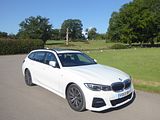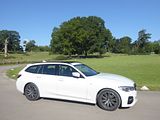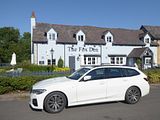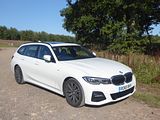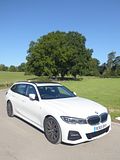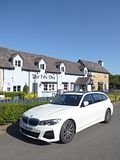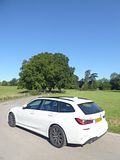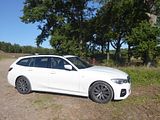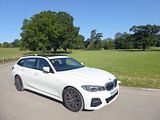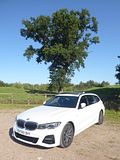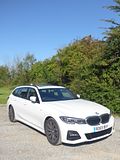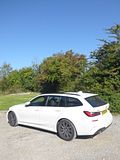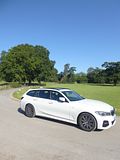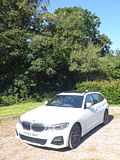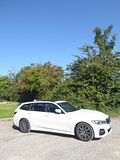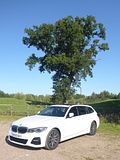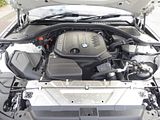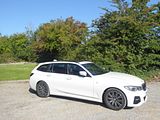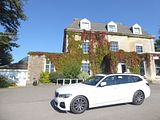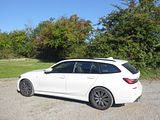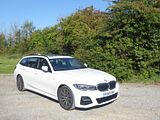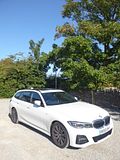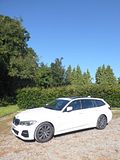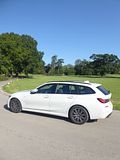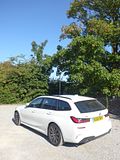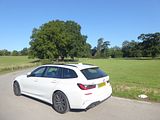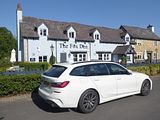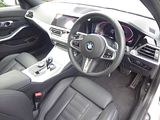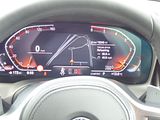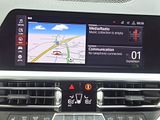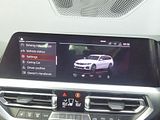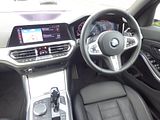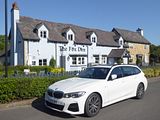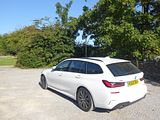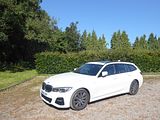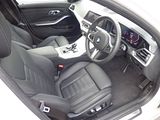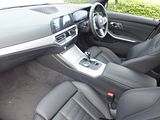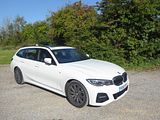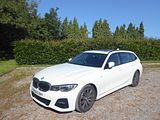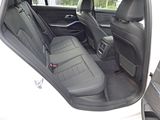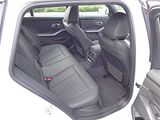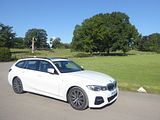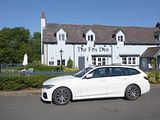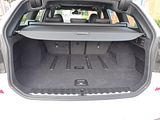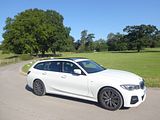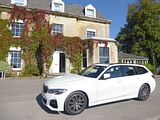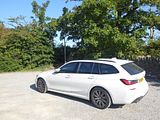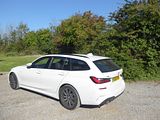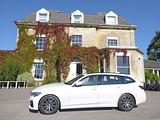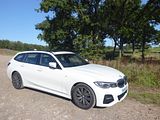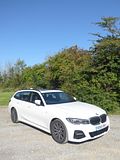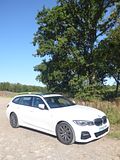To help us when comparing different cars, the marketeers and analysts have come up with various labels. Often you will see reference to A-segment, B-segment, C-segment etc, which largely denote relative size, starting with the smallest, city cars, but also it is not uncommon for people to take one of the best-selling cars in a class and use the name of that as the reference point. When it concerns the family-car sized premium sort of models, then the BMW 3 Series has become the sector defining model that is cited. It’s not hard to see why, as the name has been used ever since 1975 and although it does not have the market segment to itself, with particularly strong sales rivalry from Audi and Mercedes as well as host of other more left-field options, it has sold in large enough numbers for longer than most of us can remember that it is not hard to see why it got the class-defining label. That means that it is an important car in the market, and one that BMW absolutely need to get right. It is noticeable that when they tried to change their design approach with the Bangle era cars of 20 years ago, when it came to the 3 series the changes were far less radical than they had been with the large 5, 6 and 7 Series cars. The follow on to the E90 cars of the Bangle era, the F30 models that started to appear in 2012 followed a very cautious evolutionary path with smoothed out styling, use of the latest hardware and mechanical parts and a sizeable addition of available tech and equipment. The formula worked and sales remained very strong. So it was reasonable to assume that when the time for replacement came, that BMW would do the same again. And largely that is exactly what they did. The first of the G20 cars appeared, a bit tentatively, at the Paris Show in the autumn of 2018 and as production of the most tech-heavy model yet gradually ramped up, so the initial range started to fill out with additional engine choices, and then the full range of different body styles which have helped to make the 3 Series so attractive to buyers of so many different types of car. The first reviews were positive, with the UK press particularly effusive in their praise. They have long had a love affair with the 3 Series which borders on infatuation. My own experience of the 3 Series has seen me rather less convinced. Most of the cars I have sampled have been from the bottom of the end of the range, and whilst they were worthy enough, I was never convinced that the model was head and shoulders better than any rival, as the UK journalists would have you believe, and there were plenty of things that they either failed to mention at all, or even praised, that I actually thought were disappointing, interior quality being top of that list. So it was with some interest that I took hold of the key to the latest 320d Touring for the day, supplied as a loan car whilst my Maserati was being serviced (Dick Lovett were a bit apologetic that they had run out of Maserati loaners and were giving me this instead!). The rest was only a day and in the covid restricted world I was a bit more limited in what I could than I would have liked to be, but the drive back home, and out for some photos did see me on a variety of different roads and allowed me to form my own conclusions.
The latest 3 Series is available with a number of different petrol and diesel engines, and as has been the case for a while now, the last two digits of the model number denote relative power rather than the actual engine size. Technology advances mean that there is little difference in the power output of the similarly numbered petrol and diesel cars these days. The range starts with the 150bhp 318i and then has the choice of a 184 bhp 320i petrol or 190 bhp 320d diesel. Cars with the 330 badge can be either petrol (a 2.0-litre four-cylinder petrol unit with a maximum output of 258hp which represents a 6hp increase on the engine while peak torque has been boosted by 50Nm to 400Nm), diesel (a six-cylinder engine which extracts a maximum output of 265hp from its 3.0-litre capacity while serving up peak torque of 580Nm) or the increasingly popular and BIK tax efficient 330e petrol hybrid which has a four-cylinder petrol engine and an electric drive system integrated into the eight-speed Steptronic transmission. These join forces to generate system output of up to 292hp when the newly developed XtraBoost mode is engaged. The 330e Touring’s intelligent hybrid control combines the drive torque from the 184hp combustion engine with the power from the electric motor, which is capable of generating continuous output of 68hp and peak output of 109hp. The range is topped by the 340i which is powered by a new six-cylinder in-line petrol engine with eight-speed Steptronic Sport transmission, intelligent all-wheel drive, bespoke chassis technology and M Sport differential. The new straight-six unit delivers peak torque of 500Nm and generates maximum output of 374 bhp. Standard on the M340i and optional on the 320d and 330d is BMW xDrive intelligent all-wheel drive system and this has become an increasingly popular option. This splits drive torque between the front and rear wheels to suit the needs of any situation. The fully variable power transfer ensures maximum traction and directional stability in all road and weather conditions. The system’s rear-biased set-up helps, so we are told, to “produce the sporty driving experience”. The car I received was a 320d xDrive, in M Sport spec.
There is keyless starting which is pretty much de rigeur for this class of car now. And when the engine does fire, you will barely hear it, as this is an exceedingly refined diesel indeed. And it stays that way once you are on the move, too. The engine remains quiet at all times, and noise levels at a motorway cruise are pleasingly low with the exception of the significant and quite irritating road roar, one of the many perils, I suspect of the run-flat tyres. I will come to others later. The 320d has 190 bhp, very slightly more than the 320i petrol car, and this should prove ample for most purposes. Acceleration is strong, and the eight speed Steptronic automatic gearbox, which is standard in all models apart from those at the bottom of the range where a six speed manual is the standard fare, makes the most of the available power and torque, seemingly always in the optimum gear. There are paddles should you wish to do the job yourself, but in everyday motoring there would seem to be little point. Unlike some BMW models, the gearlever in this one seemed pretty intuitive, with a clear Park indicated on the side of the lever. I was not able to measure fuel economy, as I simply out a couple of gallons in the car so it would return with roughly the same fuel level as when I borrowed it.
If you believe the British press, this car is utterly sublime to drive, clearly head and shoulders above everything else in its class. Well, I have to say that I struggled to see what was quite so special about it. The steering wheel is chunky to the point of being too fat, as is the case with most BMW models. The steering itself is light and almost vague about the straight ahead. It does gain some weighting as you turn the wheel more, but this is nothing like as engaging as a Ford or a Mazda. M Sport models get BMW’s variable sports steering as standard, which sharpens the steering sensitivity, apparently. The handling, as experienced on the public road, whilst showing that the car is well balanced and has plenty of grip and little body roll also did not strike me as the stuff of genius, either. And then there is the ride. The car came on 225/40 R18 run flat tyres, and it is well documented that the run flats in particular do the ride of most cars no favours, and that is certainly the case here where the M Sport stiffened suspension compounds the problem. Even in Comfort mode, the ride on this one was very fidgety, and whilst it was not as bad as the 520d Touring I drove last year, I would suggest that prospective purchasers ensure that they really can live with this, even before they are tempted to go for bigger wheels, which are an option that many take up. The M Sport brakes include four-piston fixed callipers at the front and single-piston floating callipers at the rear. All the brake callipers are painted blue and display the M logo. Not surprisingly, there were no issues with the brakes, which appeared to do their job well. You now get an electronic handbrake in the centre console, but combined with the auto box this is no big deal. The 3 Series Touring uses a sophisticated array of cameras, radar and ultrasonic sensors to monitor the vehicle’s surroundings and alert the driver of nearby hazards or step in and take direct action. A smart front collision warning system, for example, is fitted as standard and will apply the brakes if it detects an imminent ante impact with a cyclist or pedestrian. It’ll also slow the vehicle or bring it to a halt if it thinks a collision with another vehicle is likely. All round visibility is as good as you get these days and to help you all models get Parking Assistant, which includes a rear view camera, front and rear parking sensors, the ability to automatically parallel and bay park and the new innovative reversing assistant.
Although there is a clear family resemblance between this and preceding BMW models, it is clear that this is the first indication of how the brand will evolve with more use of digital technology and an ever more sophisticated and larger touch screen. The overall effect is also rather more stylised than before, which you may not necessarily see as a Good Thing. Overall, I felt the interior quality to be better than the previous generation 3 series, but I would not go as far as saying it is impressive, and it is certainly not class-leading. Whilst there are plenty of decent quality and soft-touch plastics, the effect is let down more than somewhat by some cheap-looking metal inlays which have an added blue inlay which whilst providing colour contrast probably does not help matters. All 3 Series Touring models have ambient LED mood lighting as standard, with 11 selectable light designs in six colours. Some like this, of course, but it strikes me as bit gimmicky. The instrument display has moved to an all digital affair and now has octagonal shaped main “dials”, which also seem a bit gimmicky. The area between them is used for a a series of configurable options such as presentation of the map from the navigation system. There are now “proper” indicators again, the challenging one-touch system having been abandoned. Buttons on the steering wheel boss are for cruise control and audio repeaters, whilst lights operate form a rotary on the dash to the right of the wheel. The centre of the dash is dominated by the much larger touch screen, which measures 12” in M Sport models as opposed to the 8.8” unit you get in the SE and Sport cars. There are a lot of functions in here, but thankfully, there is still an iDrive control wheel and some buttons in the centre console which makes this a relatively easy system to use and there are still knobs for some of the audio functions. In addition, all models feature a voice control function, which you operate by saying “Hey BMW”. This is useful for setting up the navigation system or making hands free calls. You can also ask the voice system to find the nearest fuel station or coffee shop by saying “I need fuel” or “I’m thirsty”. There’s certainly a lot more tech in here than there was, though how much of it is really useful is perhaps a moot point. Even the standard audio unit with its six speakers is very impressive these days, so I am not sure that paying extra for an upgraded unit is necessary. Apple CarPlay is fitted as standard on all cars. BMW initially offered this as a 12 months freebie, with drivers expected to pay an £85 yearly subscription fee when the initial service expired. But in late-2019 they changed this policy and made it free for the lifetime of the car. Android Auto, however, is not available any 3 Series Touring. Beneath the unit are the buttons for the dual zone climate control. The centre console houses the iDrive controller and the button to select driving mode as well as the electronic handbrake. Although a first glance suggests that this is quite a complex car to drive, in reality, I found it relatively easy to set the things I wanted to, and simply drive off, making me wonder just how many of the settings are really all that useful or necessary.
This generation of the 3 Series Touring features newly designed seats for the driver and front passenger, and the Sports seats which are standard on Sport and M Sport versions provide a greater range of adjustment. Both the standard and the sports seats can also be specified with electric adjustment including memory function. Vernasca leather upholstery is standard on Sport and M Sport models with a choice of four colours and special decorative quilting and seam patterns that vary according to the equipment line. Like the steering wheel, the seats have heating elements in them, not something I was going to test in September! Surprisingly adjustable lumbar support is not standard on any version of the model. The steering column is manually adjustable for reach and range, and this combined with the seat movement to ensure I could get a comfortable driving position. It is worth observing that the centre console is huge and high. You would not want to have to get in on the passenger side and try to transfer to the driver’s seat in this car.
Successive generations of the 3 Series have got bigger and bigger and one beneficiary of this has been the rear passenger compartment. Even a couple of model generations back, space here was a bit tight but that is definitely not the case now, where there is ample legroom even with the front seats set well back, and also no shortage of head room. That said, thanks to the massive central tunnel, this is really a seat for two rather than three, even though there is enough shoulder room for a middle seat occupant. There are separate air vents and climate controls for the occupants here. There is a drop down armrest with cupholders in the upper surface and there are pockets on the doors for odds and ends.
The tailgate is electrically assisted, which is welcome as this is a large and heavy thing these days. You can still open just the tailgate glass if you want. 32 litres larger than that of its predecessor, the boot is a good size, nice and regular in shape, quoted at 500 litres with the rear seats in place and with ample provision of hooks and nets to help retain smaller items that may otherwise roll around. There is more space available under the boot floor, a consequence of those run-flat tyres. The rear seat backs are asymmetrically split and simply drop down to create a long and flat load area, measured as 1500 litres. Inside the cabin there is ample provision for your odds and ends. The glovebox is modestly sized but as well as door pockets there is a large lidded area in front of gearlever and a good sized armrest cubby.
Ever since the E30 second generation of 3 Series there has been a vast array of models, with lots of different body styles and engine choices, and more recently different trims even before you get to the vast long list of options and option packs. For the past couple of generations, the coupe and convertible models have diverged a little and taken on the 4 Series label, and after the largely unsuccessful experiment with the fastback styled GT of the last generation that means that cars badged 3 Series now have either a four door saloon or 5 door Touring (estate) body. The G21 generation of the BMW 3 Series Touring comes in three trim levels: SE, Sport and M Sport, of which more than half of all UK sales are the M Sport variant. There are enough visual differences that the marque expert should be able to tell them apart. As well as a line-specific front and rear bumper design, the SE comes with 17-inch or 18-inch alloy wheels, aluminium door sill strips and LED front foglamps. Standard is a restyled leather sport steering wheel with multifunction buttons and thumb rests. Sport includes BMW Individual High-gloss Shadow Line trim, plus kidney grille bars and trim elements for the air intakes and rear apron in High-gloss Black. It has 18-inch V spoke alloy wheels. Inside the Sport gets trim strips in High-gloss Black and heated sports seats in Vernasca leather. The M Sport features large air intakes at the front end to combine with M Sport design side skirts and rear apron. BMW Individual High-gloss Shadow Line trim, kidney grille bars in High-gloss Black, air intake trim in High-gloss Black and a rear diffuser in Dark Shadow. Heated sports seats with Vernasca leather, an M leather steering wheel, an anthracite-coloured BMW Individual headliner and interior trim strips in Aluminium Tetragon are standard for the M Sport model. From launch the SE and Sport is available in two non-metallic colours and nine metallic shades. M Sport customers have a choice of one non-metallic and five metallic shades. The newly introduced M Sport Plus Edition is available in a choice of three exclusive colours – Dravit Grey, Tanzanite Blue and Oxide Grey. That M Sport Plus Edition is exclusively for the UK market. This features all of the content from the M Sport Plus package including sun protect glazing, Adaptive M Sport suspension, Extended BMW Individual high-gloss Shadow Line, M Seat Belts, M Sport Braking System (320d, 320d xDrive) and M Sport Differential (330i and 330d xDrive). The M Sport Plus Edition comes in a choice of three exclusive BMW Individual exterior colours – Dravit Grey, Tanzanite Blue or Oxide Grey – along with black mirror caps, jet black 19-inch M light Double spoke alloy wheels and exclusive Aluminium Fabric high-gloss interior trim. The M Sport Plus Edition is available on the 320i, 320d, 320d xDrive, 330i and 330d xDrive models. Even without resorting to the options list, the standard spec covers pretty much all the bases these days. Entry-level SE models, for example, get 17-inch alloy wheels, LED lighting, touchscreen navigation, cruise control and BMW Park Assist with a reversing camera. Sport models add leather seats, 18-inch alloy wheels and roof rails. However, if you can live with the firm ride quality from the sports suspension, we think M Sport models offer the best level of standard equipment with a larger 12-inch HD infotainment display, fully digital instrument cluster, lowered sports suspension and a full M Sport bodykit. Standard Adaptive LED headlights with extended features include full LED low beam, high beam and eyebrow direction indicators and include a dynamic cornering light function and feature U-shaped LED units in the inner and outer headlights as daytime driving lights. The LED foglamps are horizontal and are integrated into the outer air intakes. Rain sensing wipers, dusk sensing headlights are standard, hands-free phone system and automatic three-zone climate control are standard on all models. Also featured is the BMW Live Cockpit with Professional radio with six speakers with an output of 100 watts. The Harman/Kardon surround sound system, complete with 16 speakers and a digital seven-channel amplifier delivering 464 watts of audio power is available as a single option, or as part of the Technology package. The panoramic glass roof is part of the Premium Package and is made up of a two-part glass structure to create a transparent surface of around 0.8 square metres, and an electrically operated interior blind improves headroom in the rear. Interior ambient lighting is standard in all new BMW 3 Series Touring models. The Visibility Package includes BMW Laserlight, which offer variable illumination of the road ahead and a non-dazzling high beam. With this system, the high beam function is enhanced using a BMW Laserlight spotlight with Selective Beam. As a result, the high-beam range is extended to around 530 metres, almost double that of the full-LED headlights. The High Beam Assistant (also part of the package) helps to prevent dazzling of oncoming traffic or road users travelling ahead.
Is this a 5 star car, and clear class leader? Not in my opinion. Is it a good car? Yes, absolutely. But so are plenty of its rivals. In estate car guise, of course, the 3 Series have fewer of those in saloon form, as Alfa declined to make a Guilia Sportwagon and Jaguar thought the numbers did not stack up for an XE SportBrake, sadly, but Audi will sell you an A4 Avant, Mercedes a C Class Wagon and if you don’t want to go German, then the Volvo V60 is another choice available to you. I really do think that any prospective buyer of a car in this class needs to try them all before making the final selection, as I don’t think the BMW is the shoe-in that the UK press will tell you it is. And if you decide – and the aggressive finance deals and sizeable discounts available from BMW may help you in this regard – that the BMW is indeed the choice for you, then spec it carefully. M Sport may have visual appeal, but check you can live with the fidgety ride, as whilst that Nurburgring-optimised handling may be something you benefit from rarely, you will be reminded of the ride qualities each and every day. That aside, there were no reasons I could think of why the 3 Series would not appeal, but then the alternatives are not cars to dismiss lightly, either.


